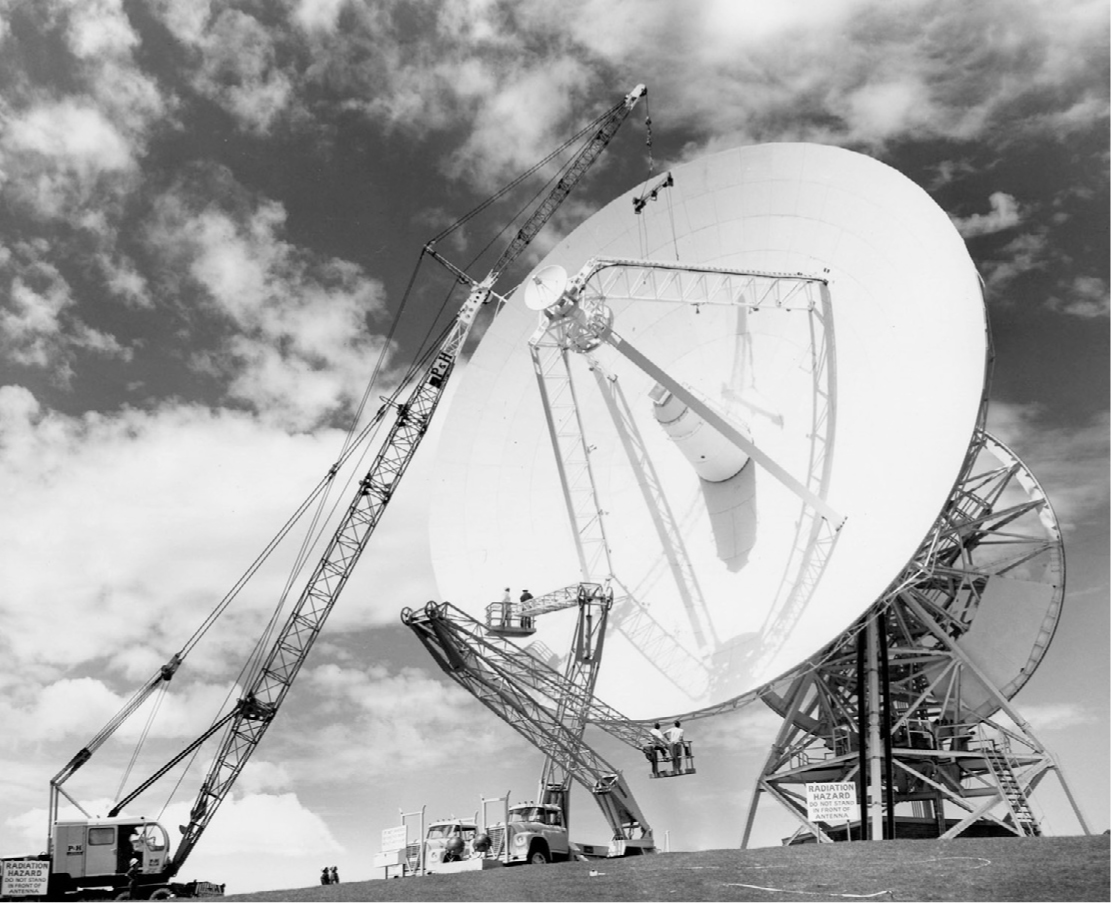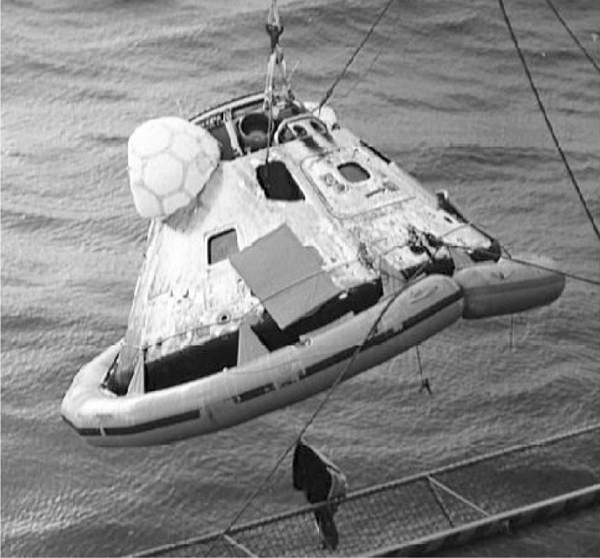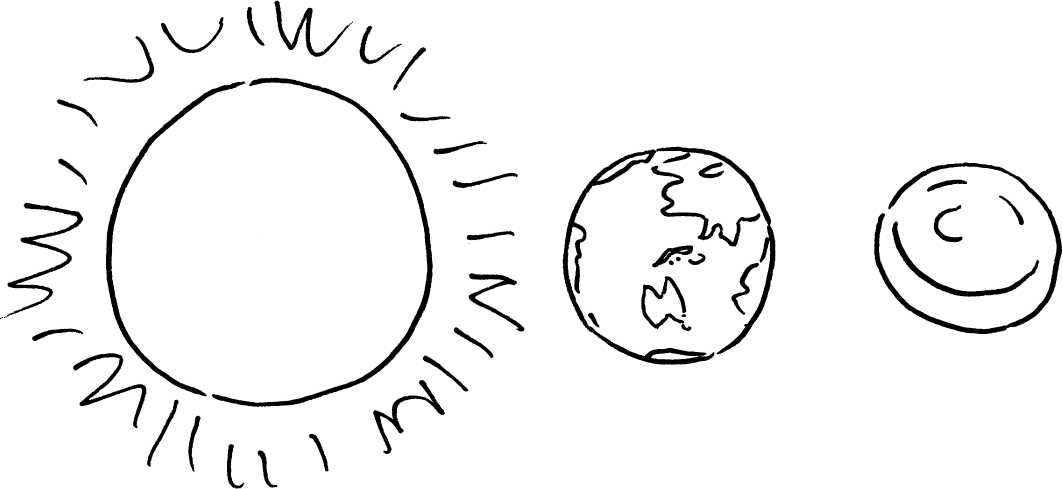Astronauts had already orbited Earth. It was now time for them to extend the horizon of space travel and orbit the Moon. Apollo 8 would be the first manned spacecraft to orbit the Moon. It was further than any human being had ever gone before — and no-one knew what would happen to a man so far out in space. Many scientists still thought that sending a human being into space was a waste of money — and far too dangerous. Machines could travel to the Moon more cheaply and without risk to human life.
The astronauts did not agree. Throughout world history human beings have risked their lives to discover, explore and chart distant lands across unmapped oceans.
NASA also disagreed. Machines are limited in what they are able to do. The human brain — and eyes and hands — will always be more adaptable than machines.
It was an awesome task to actually take men around the Moon — to calculate each step of the journey to the second. While Earth rotated at 1609 kmph, the Moon was travelling at 3682 kmph relative to Earth, and the spacecraft was moving at 40,232 kmph. Any small error would mean that the spacecraft would never get around the Moon; worse, it would miss the Moon entirely and keep hurtling through space forever.
On 21 December 1968, everyone at Honeysuckle Creek listened intently to NET 1 — the astronauts’ line to Houston, which only the astronauts and Mission Control spoke on — as Apollo 8’s countdown proceeded: minus 40 minutes . . . minus 15 minutes
. . . and then the seconds . . . 10 . . . 9 . . . 8 . . .
Everyone held their breath, hoping that nothing would go wrong to hold up the count.
3 . . . 2 . . . 1 . . .
Lift-off! Apollo 8’s huge Saturn V rocket was 110 metres high and weighed more than 3000 tonnes; the first stage alone — boosting the rocket up above the atmosphere — used more than one tonne of kerosene and two tonnes of liquid oxygen per second.
At Honeysuckle Creek our Station Readiness Testing was complete. We waited for the spacecraft to pass over us on its first Earth orbit. All systems were go when we had our first AOS (Acquisition of Signal). There they were! For a whole ten minutes Apollo 8 passed over us — and then they were gone again, orbiting Earth.
Finally they did a second burn of the rocket engine, and started on their three-day trip to the Moon. The three astronauts — Frank Borman, James Lovell and William Anders — stared out through the window as Earth grew smaller and smaller, shrinking to a blue ball in the darkness. Lovell finally put it into words to Mission Control: ‘Boy, it’s really hard to describe what this Earth looks like . . . Tell the people of Tierra del Fuego to put on their raincoats — it looks like a storm down there.’
Today we are used to satellites sitting in outer space, sending back pictures of what the weather is like, or beaming back images onto our TV screens, or transmitting voices from mobile phones. All of us have probably seen the photos of that brilliant blue globe, swirled with white — our Earth. This was the moment in history when it all began.
Apollo 8 travelled further and further away from Earth. At Honeysuckle Creek, Hamish Lindsay’s job was to operate the ranging system, measuring the distance to the spacecraft — and he says the thought of that first awesome mission into space still grabs his stomach! He could see the distance between Earth and the spacecraft getting steadily bigger and bigger. ‘If anybody tells you we never really went to the Moon, I know they don’t know what they’re talking about. We did, because I was measuring the distance to the spacecraft all the time — accurate to a metre.’
It took three days for the tiny craft to reach the Moon. Anders later confessed: ‘The long ride out to the Moon was, frankly, a bit of a drag.’ It was difficult to sleep; the cabin was only three metres by four metres and there were three of them in it — and it was noisy too.
Borman started vomiting. In the tiny cabin this was a serious problem — especially in weightlessness. Each blob of vomit drifted around and had to be caught before one of the astronauts crashed into it. The astronauts were also concerned that Borman might have been exposed to a dangerous dose of radiation. Would they all get radiation sickness? Borman recovered quickly, from what was probably a virus.
The astronauts were hoping for a brilliant view of the Moon as they got closer to it, but they were disappointed. The Moon was indistinct and fuzzy, dwarfed by the light of the Sun behind it.
All of us at tracking stations across Earth could see the spacecraft begin to go faster as the Moon began to pull it closer into its gravity. Things were running perfectly in space, but at Honeysuckle Creek there were problems.
Our antenna had developed a serious problem. The feed cone in the middle of the ‘dish’ — the cylindrical centre of the dish that contained all the sensitive receiving equipment — began to spark. It was unable to receive signals from outer space.

Working on the 26-metre antenna during the Apollo 8 mission. A crane and two cherry pickers remove the feed cone for repairs.
HAMISH LINDSAY
There was no time for panic, we simply had to replace it — fast. This meant cranes, floodlights, technicians and all other available people crawling over the antenna, working nonstop. Even working at record speed it took hours to get a new feed cone into position. During this crisis we didn’t lose the signal from Apollo 8. We used the antenna at Tidbinbilla Tracking Station, the Apollo 8 signals transferred across the microwave link to be processed by our Honeysuckle Creek computers.
Before long it was time for Apollo 8 to head behind the Moon — out of reach of any signals from Earth, into territory no-one had ever seen before. On Christmas Eve, Apollo 8 slipped behind the Moon. At this point we could not receive further communication or data from the spacecraft until the astronauts came in sight of Earth again.
The farewell message from Mission Control in Houston was: ‘Apollo 8, you’re riding the best bird we can find.’
Astronaut Anders, the pilot of the command module, replied: ‘Thanks a lot, troops. We’ll see you on the other side.’
For the first time the astronauts were alone, with no Earth voices to reassure them. It was a world of darkness — night-time on the other side of the Moon, blackness below them, stars above them, and silence from radio transmission.
Hamish Lindsay was on duty that day, and remembers: ‘We were all locked onto the signal coming in steadily. Then suddenly my signal cut out as the spacecraft went behind the Moon, and we all wondered what would happen. Would they come out safely? Was there something behind the Moon we didn’t know about? Someone jokingly said, “What about the mountain we don’t know about? It could be higher than the spacecraft and they might crash into it!”’
We all waited for what seemed like hours. I was watching the antenna television screen — it was showing the crescent moon, with the antenna bulls- eye marked on the screen sitting right on the edge of the Moon’s rim.
We knew the exact time that the craft was supposed to appear from behind the Moon — this had been worked out by mathematicians and computers at Mission Control. We waited holding our breath for that moment.
I had a quick look around — all the other operators were glued to their consoles, spring-loaded to grab the first signs of any signal from the spacecraft. For the crews at all the tracking stations on Earth this was a time of incredible suspense. If anything went wrong while the spacecraft was out of range we would never know what had happened, or why.
The Moon was shining above the Honeysuckle Creek hills. We were the ones who would receive the first signals when, if, the spacecraft reappeared. We would be the ones who would broadcast to the world whether Apollo 8 was lost or safe.
Far behind the Moon the spacecraft’s rockets did fire, right on schedule, providing power for the craft to go into lunar orbit. (If the rockets had failed the craft would have sped off into deep space.) And now as the spacecraft moved around the Moon the astronauts became the first human beings to see the surface of the far side of the Moon in daylight, only 60 kilometres away from them — a world of clear harsh light, with no atmosphere to blur it, alien hills and sharp dark craters. According to Lovell it looked like ‘. . . a pile of sand my kids have been playing in for a long time’. To Borman it looked like ‘. . . dirty beach sand . . . a vast, lonely, forbidding type existence, a great expanse of nothing . . .’.
Seconds passed. We waited — and then we heard their signal, clear, sharp and perfect. Through Honeysuckle Creek the message flashed to Houston: ‘Go ahead, Houston. This is Apollo 8. Burn complete. Our orbit is 169.1 by 60.5 miles.’
And Houston replied: ‘Roger, Apollo 8. 169.1 by 60.5. Good to hear your voice.’
The astronauts were safe — for the moment.
Early on Christmas Day, and after completing ten orbits of the Moon, the spacecraft’s rockets had to be fired again to position it on the correct flight path for the homeward journey to Earth.
We had a special Christmas dinner at Honeysuckle Creek, but apart from that, Christmas hardly existed for any of us at the tracking station. The most dangerous parts of the mission were still to come. If the engines failed the crew would be stranded, orbiting the Moon until their air ran out nine days later.
Hamish Lindsay said: ‘After ten times around the Moon it was all on again for the ride home — they had to have a rocket burn to bring them back to Earth, and it had to happen out of contact behind the Moon.’

The Apollo 8 capsule is being hoisted aboard USS Yorktown after its successful splashdown.
NASA
Again we were hanging in suspense waiting for the spacecraft to come from behind the Moon. What if the rocket engine hadn’t fired, or fired at the wrong time? They would be doomed to die, far away from home in the lonely reaches of the Moon. There was no-one to help them.
All around the tracking stations and at Mission Control everyone went quiet. This was the last unknown. ‘Swallow the frights one at a time as they appear in the Flight Plan,’ as astronaut Michael Collins once said.
Right on the planned moment we received the signals, and heard astronaut Lovell’s voice again, this time saying in answer to Mission Control’s call, ‘Please be informed there is a Santa Claus,’ and we all knew they were heading for home. Apollo 8 was a success and further Moon missions could go ahead.
The astronauts still had to get back to Earth safely.
Apollo 8 re-entered Earth’s atmosphere at a far greater speed than previous Apollo spacecraft — 39,000 kmph. If it came in at too shallow an angle, it would skim off the atmosphere and out into space; if it came in too steeply it would burn up.
The re-entry was perfect and, with what Borman called a ‘real bone-rattling jar’, the capsule splashed down in the Pacific Ocean 6.5 kilometres from the aircraft carrier USS Yorktown. A helicopter from the Yorktown set out to bring the astronauts in — carrying a razor so that Borman could shave off his whiskers before he posed for the cameras!
At Honeysuckle Creek those of us on duty had another great meal — a baked dinner with home-made gravy and all the trimmings, and pudding — a special ‘splashdown’ dinner that Horrie and Betty Clissold, who managed the canteen, put on for us at the end of every mission.
It tasted great. We all felt very smug indeed.
It takes 27 days for the Moon to orbit Earth and there are 29-and-a-half days from full moon to full moon, which depends on the relative positions of the Sun, the Moon and Earth. When it is full moon the Moon and the Sun are on opposite sides of Earth. The whole face of the Moon is visible, illuminated by sunlight.
Because it takes 365-and-a-bit days for Earth to go around the Sun, and 29 and a half doesn’t fit neatly into 365 and a bit, the number of days in each month were adjusted to fit neatly into a 365-day year.

Without this adjustment Christmas might occur in summer one year and in winter a couple of decades later, as the months wouldn’t match the seasons.
HOW DOES THE MOON MAKE THE TIDES RISE AND FALL?
Both the Sun and the Moon control Earth’s tides. Although the Sun is larger than the Moon, it is much further away. Its gravitational pull is only half as powerful as the Moon’s when it comes to affecting large bodies of liquid on Earth, like the oceans.
The closer the Moon is to Earth, the more powerful is its pull. This makes the water just under the path of the Moon tend to bulge upwards a bit, with another smaller bulge on the opposite side of Earth. The bits that aren’t bulging at all are a ‘low tide’ and the bulgy bits are a ‘high tide’. (And even solid Earth bulges a bit — you rise and fall about half a metre but don’t realise it.)
There are two high tides and two low tides every 25 hours, because the Moon rises an hour later each day.
Once a month we get even larger tides when the Moon is closest to Earth. Larger tides also occur when Earth is closest to the Sun, which happens in early January in Australia.